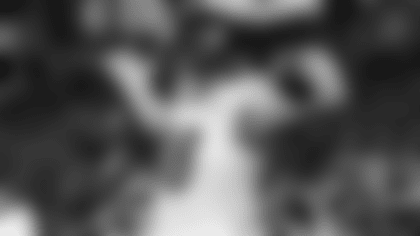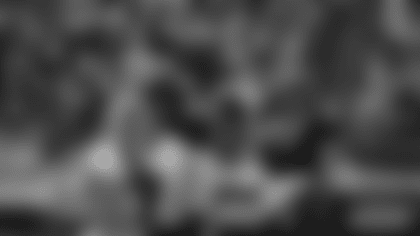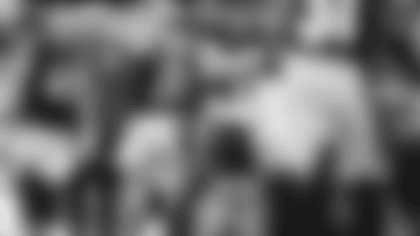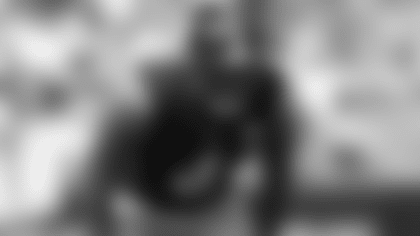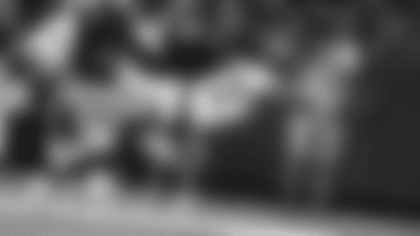Q. At your news conference on Tuesday, you clarified the QB situation by explaining that until Russell Wilson is cleared medically to return to practice, you will proceed with Justin Fields as the starting quarterback. Beyond what the medical staff might tell you, what would you need to see as a coach from Wilson to make you comfortable that he's healthy?
A. The medical staff component of it is centered around his health and his ability to protect himself. The coach component of the decision is centered around his ability to be productive, to not be limited schematically, pocket movement, play-action pass, things of that nature where he's got to have some reactionary quicks and movement and utilize his legs. And so those really are the hardcore variables in the equation. Health and then his ability to do all the things that we ask someone in his position to do.
Q. What does a healthy Russell Wilson look like?
A. You know, the guy who we watched for 10-plus years in this game. Mobility and reactionary movement is a component of his game, and always has been. Pocket movement, getting on the perimeter, the long ball component that's associated with play-action pass and launch point changes. That's what he's about.
Q. Also you said this about Justin Fields: "The development of our relationship and me getting to know and understand him, him getting to understand me, it just grows in in-game environments." What does he need to understand about you?
A. I think we all have a personality, if you will, and I think that when you don't work together, there are some things to be explored there. Some people have an off-the-field demeanor that could be dramatically different than the in-game demeanor, both players and coaches. And so I'm just acknowledging the existence of that. I'm probably not one of those guys, but I think people need to grow and understand that the same tone and the way I interact on the course of the game week is generally the same tone that I have in-game. And that's to be discovered, probably by those who are new to me. And I just respect the fact that the real components of our relationships are born in real adversity, and that real adversity is produced on game day inside stadiums.
Q. You will sometimes offer praise to one of your players by saying "he runs to a challenge." How does a player display that to you?
A. Smiling in the face of adversity. Showing general enthusiasm, maybe when they shouldn't. That's why we do some of the drill work that we do at training camp. I tell the guys all the time, drill work is football-like, it is not football. We're putting someone at an advantage. We're putting someone at a disadvantage. And then we want to see them compete. I want to see if the guy in the advantage can win and win consistently. I want to see if the guy who's placed at a disadvantage smiles in the face of adversity and fights every single snap. When we do backs-on-backers, the backs are at a disadvantage, because they're not allowed to cut-block in that drill, for example. And so they're somewhat sitting ducks. That's why I was so excited at Friday Night Lights when I saw the running back group smile in the face of that and compete with the energy and the enthusiasm that they did. And that's just an example of it. That's why we do the drills that we do and work the way that we work, because I've got to create an environment where that gets revealed to me, and we train guys how to respond to adversity.
Q, In last week's win in Denver, Broderick Jones was flagged for 3 penalties within 6 snaps, and afterward when asked if you pulled him from the game because of those penalties you said, "You got it." Specifically, was it how many penalties he committed, or what kind of penalties he committed, or the frequency with which he committed them in a short span that caused you to act?
A. All of the above. All of the above. You know, when it's talking to you, you listen. Penalties are drive killers, particularly during the early portions of the season. Yes, it was the type of penalties that he was getting, the frequency in which they occurred, the speed in which they occurred, all were components of the decision. And really it was no decision. I tell my guys all the time: I don't make decisions. I just squeeze triggers. They load the gun. He loaded the gun in that instance.
Q. When that happens to a player, is the breakdown a physical one in terms of his fundamentals, did he lose his poise, was it his immaturity as a player, or something else?
A. It can be a myriad of things. I'd be painting with a broad brush if I characterized those circumstances in any one particular area. It's usually a myriad of things that are occurring when you're not getting the desired technique that you wish. Lack of physical repetition that creates muscle memory, anxiety, lack of knowledge, lack of experience. It could be a myriad of things, to be quite honest with you, or combinations of the above.
Q. In your follow-up dealings with Broderick, do you go with encouragement, tough love, or challenging him as a professional as the quickest way to rehabilitate him?
A. I don't know that I'm looking for quick. I'm just looking for appropriate. And really, that mode depends on a lot of things – the player, the nature of the infractions, our relationship, his coachability in terms of the things that he responds to from a coaching standpoint. And so there are a lot of variables that are a component of that equation. I don't think there's a cookie-cutter answer to that, particularly if you're trying to coach at a high level. Different people need different things, and it's our job to know what it is they need and how it is they need to receive messaging.
Q. How would you evaluate your wide receivers besides George Pickens so far?
A. I like the work that they've done. I don't know the statistics reflect it, but people oftentimes don't know our intentions in-game. We were in two road game environments to start the season. We were committed to being not behind the chains, to being on schedule, to minimize the crowd component of it, to realize that since it's the early stages of unit development, you're not going to overcome behind-the-chains moments. We have run the ball in terms of attempts more than anybody in the NFL over the course of two weeks, and so that's going to produce numbers that lead you to ask that question. But I'm not in any way discouraged by the contributions of those guys. As a matter of fact, I'm pleased with the work of those guys, and I just think that is going to continually be revealed once we get a larger sample size, when we get at-home venues and things of that nature. The Atlanta Falcons, for instance, had a quality safety tandem in Isaiah Simmons and Jessie Bates. To be quite honest with you they're the very best players on that unit, so we were not throwing the ball in the middle of the field. If you noticed, any ball we threw down the field in that game was outside the numbers. And so there are a lot of things that happen from a game planning standpoint that could produce questions or statistics that produce questions this time of year. My answer to that always is, it's a small sample size. Keep watching.
Q. In talking about today's game against the Chargers, you used the boxing analogy that styles make fights. What's the Steelers' style as we sit here today?
A. We like to mix it up. If you're making it the boxing analogy, we like to wage a war of attrition in the line of scrimmage with our bigs on both sides, offense and defense. I believe that Jim Harbaugh teams live the same life, and that's why I think it's going to be a really exciting game. We lead the league in rushing attempts. They lead the league in rushing yards. The teams have two top-notch defenses. I think they're No. 1 in points per game allowed, and we're No. 2 in points per game allowed. And so that's what I mean when I talk about the analogy that styles make fights. It's also an opportunity for me to educate our young guys about boxing history and just competition. I said it's like Hagler-Hearns, but most of these guys don't know Marvin Hagler or Thomas Hearns, and so it's an opportunity for them to get on YouTube and watch about 9 minutes of action of what might be the greatest boxing match of all time.
Q. In talking about last week's game, you said Denver tried to protect its rookie quarterback by running the football, and so Job 1 for your defense was to "attack the run" so the Broncos couldn't do that. How does a defense attack the run?
A. By minimizing it. We characterize football as a game of inches, and it gets cliché-ish at times, but it is real. Sometimes winning and losing in terms of the run game is just what direction the pile falls. From the moment of initial contact, what direction does a pile fall? For us, we want that pile to fall backward when our defense is on the grass. We want that pile to fall forward when our offense is on the grass. And so, although subtle, repetitively over the course of 60 minutes it becomes a major factor in the game of football. And so what I was speaking to there is I want that pile to fall a certain way. And so we've got to play in a certain spirit. We have to shed blocks, we've got to make tackles, we've got to turn ball carriers back. And these guys have some talented ball carriers that we're very familiar with, in J.K. (Dobbins) and Gus (Edwards), and particularly Gus in terms of being a downhill guy. Gus' pile almost always falls forward. And so we've got a big challenge in that regard.
Q. The Chargers, with offensive coordinator Greg Roman, also figure to want to run the football. Can your defense attack the run today the same way it did in Denver, or does Justin Herbert being a veteran quarterback force you into a different strategy?
A. For us it's a coach's challenge in that we need to anticipate through a variety of means when they're running the football and make sure that we have ourselves in an appropriate defense to do so. The Herbert factor is a coaching challenge. It's our job to ascertain when they're going to run it, when they're going to pass it, and schematically put ourselves in position to defend each. That's the strategy component of the game that I love. That's not our guys' responsibility. In run-down circumstances if Herbert is having a good day, then it's my fault. I work all week trying to ascertain when that's going to happen, and I feel really comfortable about our position in that area. But that's every week. That's the challenge every week. They can run it, they can throw it. Usually it requires a single-high safety to stop the run. If you knew they were going to throw it, you'd take a two-high safety principal. And that's the strategic component of play week in and week out, not only for us, but for most of us in the league.
Q. Justin Herbert was the sixth overall pick of the Covid draft of 2020, and there wasn't much pre-draft preparation done that year. But now that Herbert has been in the league and you've had an opportunity to study him on video, how would you describe him as a player?
A. In 2021 when we played him, we underestimated his mobility. And all you've got to do is look at the box score to get a sense of that. He ran for 90 yards on scrambles in that game, and we didn't have the proper schematics to minimize that. And so you learn from your mistakes, at least you try to learn from your mistakes. We're aware of his arm talent, his talents in the passing game, his ability to diagnose in a timely manner, how well he operates against five or more rushers. What we didn't have a feel for was his escapability and his athleticism. Sometimes you really don't feel that until you're in-stadium with someone. And so we learned a tough and painful lesson in 2021 in Los Angeles. We better show today that we learned that lesson. This guy is multi-talented. His throwing exploits are well documented, but he's got some danger to him from a mobility standpoint that we better respect and minimize in this game as well.
Q. You talked about Gus Edwards earlier. What style of a running back is J.K. Dobbins?
A. He is patient and he's got great vision, and I think that's what makes him a good sidecar runner. He was drafted in Baltimore to be a sidecar runner, meaning they operate a lot out of shotgun to enhance quarterback mobility, zone-read, zone-read keeps, and so forth. And generally, the backs who operate in that structure have to show a great deal of pick and patience and vision, and that's something that he does. He's a D-to-D runner, and what I mean is he can get a ball on the midline, around the center and A-gaps, and bounce it or cut it back. It's a major component of what they do. He's popped some big-time short yardage runs this year by showing that pick and vision, that D-to-D vision. And so not only do we have to deal with him in first-down second-down circumstances, but he's got a 46-yard run and he's got a 43-yard run in third-and-1 situations already this year. And that speaks to his vision, his ability to go D-to-D. Sometimes you load the box and you get people close to the line of scrimmage, and when you're playing a back with that type of patience and vision, when they come out of it, they can turn short-to-long. And so there are a lot of challenges involving him. But we're familiar with him, and we're excited about facing that challenge. This weekend, we've got the NFL's leading rusher coming in here, and if you're a competitor, that turns you on.
Q. The Chargers have a couple of flame-throwers at the Edge positions in Khalil Mack and Joey Bosa. How do they deploy them?
A. In a very similar way that we utilize T.J. and Alex, to be quite honest with you. Not that we're being disrespectful to Bosa's and Mack's talents or their resumes, but through team development we practice good on good. And so our offense is used to functioning against unique edge people and people who can change the outcome of a drill or the outcome of a play or a game. We function in that mode for the month of August in training camp, because if you're not careful, not only in terms of individuals, but in terms of the collective, in terms of schematics, T.J. Watt can ruin a practice. There are so many benefits to having really good players on your team. When we're faced with dynamic edge tandems we go right back to training camp mode, because we've got an edge tandem that's capable of taking over a practice. The Chargers have an edge tandem that's capable of taking over a game. And so we've got physical experience, both schematically and as individuals, in terms of dealing with that. For me, when we get in games like this, it's all about what edge tandem wrecks the game first. "It better be ours" is the messaging that I send to our team, and that is no different than we play Cleveland. I always say, "Who's gonna wreck the game first, T.J. or Myles Garrett? It better be T.J."





